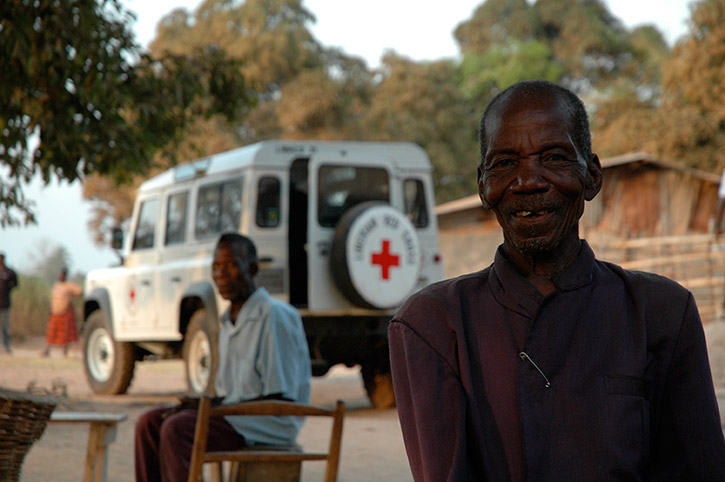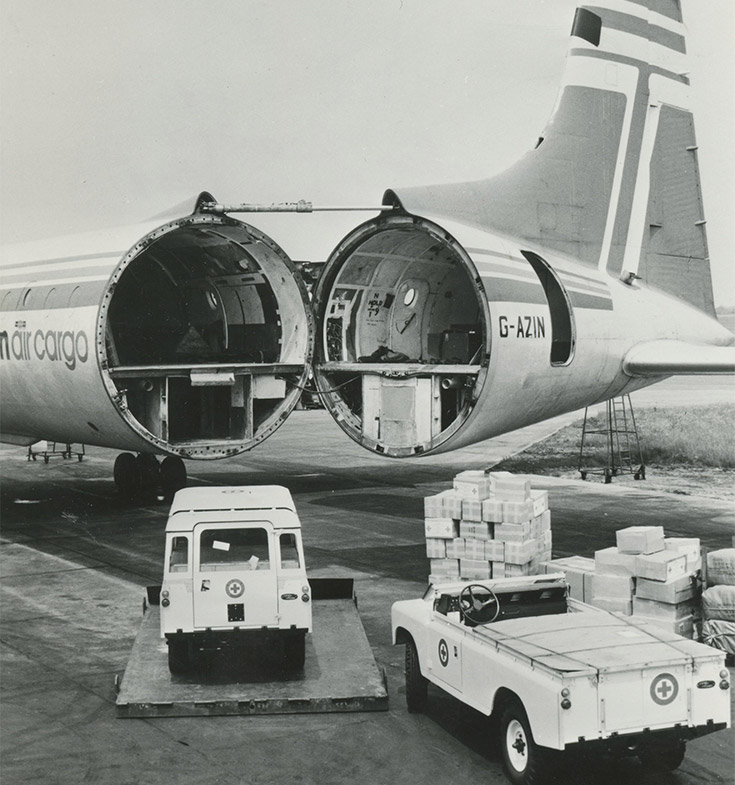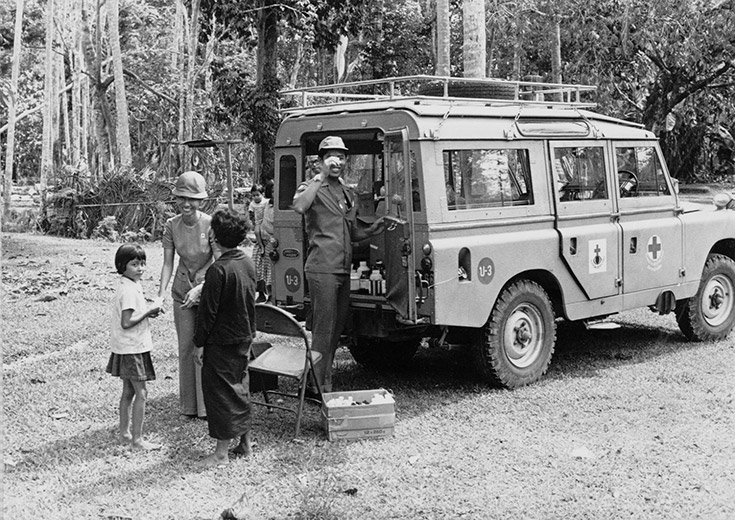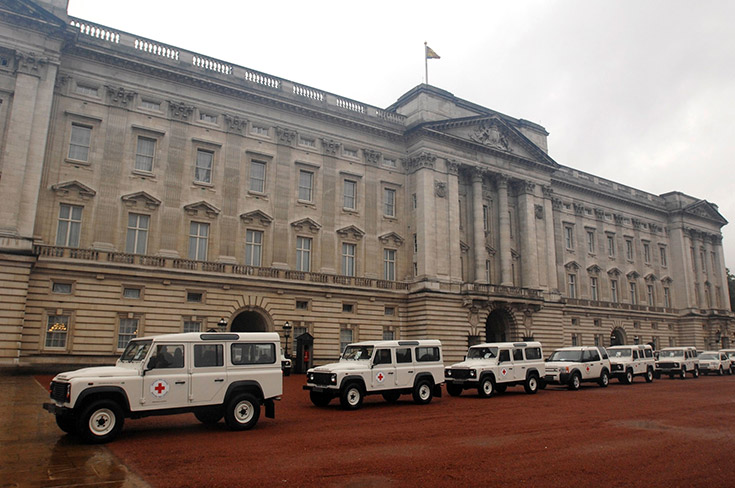Pictures: Sixty years of the Land Rover Defender and Red Cross
For over 60 years, the Land Rover Defender has been one of the vehicles used by the British Red Cross and International Federation of Red Cross Red Crescent Societies around the world. Here are a few examples of how the Defender has been used for emergency relief following natural disasters and to support humanitarian projects.

1950s
In 1954 Land Rover donated a long wheel-base Defender Series 1 to the British Red Cross for use in Dubai – part of the Trucial States. This was modified for use as a mobile dispensary with a stretcher, water and washing facilities. It was used as a base for treating over 5,000 patients in Dubai and the surrounding desert areas, travelling more than 17,000 miles in under nine months.
That same year saw Defenders being adapted and used elsewhere as mobile dispensaries. In Kenya and Korea, their role was to visit outlying, remote villages, enabling staff and volunteers to run clinics, distribute milk and provide health education.
The British Red Cross annual report for 1954 noted the observations of aid worker Joan Wittington – later to be recognised with an OBE – as she travelled across Kenya in a Defender: “Many of the villages are 9,000ft up. I went to several of them, travelling in a Land Rover … the Red Cross team has a Land Rover and visit each village several times a week, running clinics, organising milk distribution and giving health teaching and handcraft instructions to the women and girls …”
1960s
Land Rover Defenders were adapted to act as ambulances and transport medical supplies and people to hospitals in Angola and South Africa.
In 1961, The British Red Cross reported that: “The ambulance arrived safely in Durban, South Africa. From there it was driven up the spectacular Sani Pass, which is only negotiable by four-wheel drive vehicles, and over the Drakensberg mountain range where the jeep track reaches a height of over 10,000 feet. The shining white ambulance with its Red Cross markings … was to play such an important part in helping to save the lives of their sick and injured. No longer would they have to endure the agonising journey on horseback to the hospital in Mokhotlong village, many miles away.”
1970s
Relief aid was transported by Land Rover Defenders in emergencies and natural disasters in places as far afield as Rwanda, Ethiopia, Turkey, the British Virgin Islands and Nigeria.

Supplies for an appeal by the Ethiopian Red Cross, 1978
In the Biafran conflict in Nigeria, Defenders enabled aid workers to distribute food and milk to communities in remote areas.
On the other side of the world, Defenders were used following Hurricane Fifi in late 1974, the catastrophic cyclone that killed thousands of people in Honduras. The hurricane caused widespread flash flooding, landslides and damage that left many people homeless.
When thousands of people were made homeless in earthquakes in Turkey in 1976, a Land Rover Station Wagon and a Land Rover pick-up van were sent to help transport supplies of tents and other relief aid. The British Red Cross sent two consignments of winter coats, sleeping bags and tents, to help the 60,000 people made homeless by the quakes.
Two years later, The British Red Cross airlifted vehicles to help the huge relief effort for refugees, displaced by years of fighting in Ethiopia.
In response to an appeal for help from the Ethiopian Red Cross, the British Red Cross airlifted four Land Rover Defenders to the area together with three tons of medicines donated by the Red Cross in the Federal Republic of Germany.
Land Rovers were used elsewhere for community support programmes. This Defender, shown leaving the British Red Cross' warehouse at Kingsbury, to go to the British Virgin Islands, helped take disabled children to school.

A Red Cross dispensary during floods in Thailand, 1975
1980s and 1990s
Land Rovers helped to distribute aid and reach vulnerable people in crisis. Defenders were sent to Sudan in 1984, to help distribute aid following the disastrous drought and famine that left 8 million people at risk from starvation.
2000s
Vehicles continued to be used in UK and international operations. The relationship between Land Rover and the International Red Cross Red Crescent Societies (IFRC) started to move to a formal footing, and 2007 saw the first phase of a partnership with Land Rover, raising over £2.5 million and helping the IFRC reach nearly 100,000 people around the world.
In 2008, Land Rover donated 60 vehicles, including Defenders, to the British Red Cross on the occasion of the company’s 60th birthday. The vehicles were formally handed over at a ceremony at Buckingham Palace.

To mark its 60th anniversary, Land Rover donated 60 vehicles, seen here outside Buckingham Palace in 2008 (photo: Jonathan Banks)
Half the fleet remained in the UK, while the other 30 were shipped overseas to Liberia, Lesotho, Mongolia and Sierra Leone.
A Defender in action in Sierra Leone
Eight Land Rover 4 x 4 vehicles were donated to the Sierra Leone Red Cross (SLRC) to help volunteers reach people in remote and vulnerable communities to recover from the trauma of civil war, and provide counselling, basic education, vocational training and help them reintegrate into their communities. As road conditions across the country were poor, the SLRCS had struggled to reach vulnerable people until the Land Rovers arrived.
A Defender in the Cayman Islands, 2008
Other Defenders were also sent to Kyrgyzstan where the Kyrgyzstan Red Crescent Society used them to reach the elderly, disadvantaged, children and young people, vulnerable women and migrants, and people living with HIV and TB. A combination of economic collapse, high rates of poverty, and mountainous, frequently inaccessible terrain at high risk of earthquakes, avalanches and landslides meant that reliable transportation for volunteers on the health and social care programmes was essential. The Defender was put to daily use, both in the capital Bishkek and throughout the country, and was frequently called on at short notice to respond to natural disasters in the region, allowing the disaster team to reach remote areas without accessible roads or snow passes.
In Mongolia, the Red Cross used Land Rover Defenders for its health and social care programmes, including a social inclusion programme for isolated and vulnerable people.
With its extreme climate, vast steppes and fragile soil, Mongolia is one of the most sparsely populated countries in the world. The Mongolian Red Cross is often reliant on 4x4 vehicles to access vulnerable people in rural communities cut off by significant snowfall, earthquakes and floods.
With Land Rover’s support, the British Red Cross was able to support a Mongolian Red Cross project called 'Social Care for Vulnerable and Elderly' helping with household and personal chores and bringing food and medicines in Ulaan Baatar.
From disaster relief in Turks & Caicos following Hurricane Ike in 2008 to the devastating 2010 earthquake in Haiti, and severe flooding in Pakistan in 2011, Defenders have continued to play their part in ensuring that volunteers could provide essential relief in large-scale emergencies and natural disasters.
Vehicles being presented to the British Virgin Islands in 2009
2010
Bad winter weather in the UK in 2010 saw Defenders well-used across the country to reach vulnerable and isolated people. Additional vehicles were loaned by the company for use in Cumbria.
Snow in Scotland, 2010
Staff and volunteers used specially adapted Red Cross four-wheel drive Land Rovers and ambulances to support the ambulance service in the East Midlands and in Hampshire where they reached 1,000 drivers stranded overnight on the snow-bound A3.
Flooding in Cockermouth, Cumbria, UK, 2010
2010 was also the start of a new global corporate social responsibility (CSR) initiative – ‘Reaching Vulnerable People Around the World’ – between Land Rover and IFRC. This involved Land Rover supporting projects with financial assistance and vehicles provided to a hygiene and sanitation project in South Sudan (via the Austrian Red Cross) plus funding and employee volunteering to support the Portuguese Red Cross’ health and social care work. As a result Land Rover won the award for best long-term partnership at the Third Sector Business Charity Awards 2011.
In 2013, the partnership was extended for a further five years with an ambitious new target of providing £15 million-worth of support to some of the most vulnerable people around the world. The projects fall into three distinct areas aligned to Land Rover’s CSR strategy: Health and social care; water and sanitation; and helping communities develop a resilience to cope with potential disasters and crises.
Today the Defender continues to be used by the British Red Cross year-round as part of its fleet of vehicles stationed around the UK, which are ready to help in an emergency, reach people in crisis living in isolated areas, or in periods of bad weather such as heavy snow and flooding. The vehicle also continues to be used overseas – in South Africa, Rwanda and Sudan for example, where Defenders are used at projects such as a water and sanitation installation in Sennar State - one of many funded by the company.

Land Rover has built a special vehicle to commemorate the UK production of the two-millionth Series Land Rover and Defender. The Defender 2,000,000 has been created to almost seven decades of Land Rover production in Solihull, UK. British Red Cross CEO Mike Adamson fitting a part to the two-millionth Land Rover. In December 2015, collectors and Defender fans will be given the opportunity to own this unique piece of Land Rover’s history when it is auctioned by the renowned auction house, Bonhams. Reflecting Defender’s heritage, all proceeds will be donated to Land Rover’s humanitarian and conservation partners – the International Federation of Red Cross and Red Crescent Societies (IFRC) and the Born Free Foundation.